Next year marks the 40th anniversary of the last manned voyage to the Moon. The Apollo 17 astronauts, Eugene Cernan and Harrison Schmitt (the latter, a geologist, the only scientist-astronaut of the Apollo programme) left the Moon on 17 December 1972, leaving behind them a plaque bearing the words: ’Here man completed his first explorations of the Moon.’
With the last mission of the space shuttle underway and NASA’s plans for future manned missions to space seemingly on hold, it might seem odd to talk about the Moon as a target for exploration. But for a number of organisations, the race to the moon is back on, with the prize of increased scientific knowledge and, some are convinced, of enormous financial gains.
The US, Russia, Japan, China and India all have active manned Moon-landing programmes with somewhat elastic timetables. Moreover, 29 teams are competing for a $30m (£19m) prize, funded by Google, to be the first privately funded organisation to land a robotic probe on the Moon.
Google is funding a Lunar X Prize, one of the competitions organised by the US-based X Prize Foundation, aimed at solving technology-based problems without public funding. The best known of these, the Space X Prize, was won in 2004, with Scaled Composites’ SpaceShipOne taking the $10m prize for the first suborbital flight of a non-government-funded craft.
The Space X Prize was the springboard for Virgin Galactic and SpaceShipOne’s successor, SpaceShipTwo, is currently undergoing flight trials ahead of a planned first commercial flight later this year. With Virgin Galactic claiming to have secured some 500 customers, each paying $200,000 for their flight, commercial space flight certainly seems to be a sound and potentially lucrative venture. The Lunar X Prize entrants have similar hopes.
’Some people argue that the first group of trillionaire entrepreneurs will be involved in the commercialisation of space,’ said Michael Potter, leader of the first team to register for the Lunar X Prize, Odyssey Moon. Based on the Isle of Man, although working mainly from San Francisco, the organisation has already secured a number of customers for lunar landing services from a surprising range of sectors, from hard science to performance art. With Potter quoting costs of up to $5m per pound of payload, it certainly seems like the Moon is a viable business proposition.
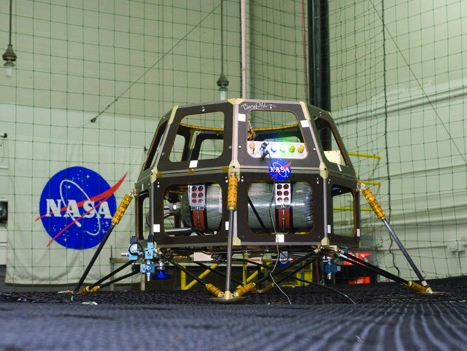
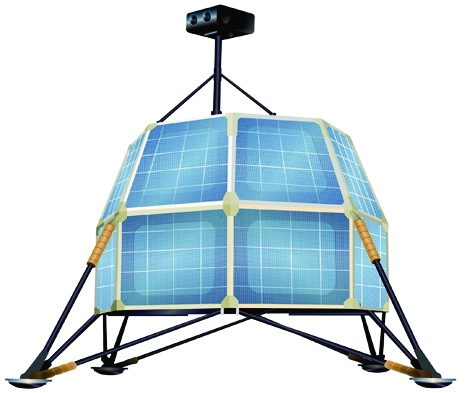
But for him, commercialising the Moon is just a logical step for the space industry, which is already huge. Space commercialisation began with the invention of the geosynchronous satellite in 1963, Potter argued, and has since become a multibillion-dollar industry.
“In a sense, we’re looking at ourselves as selling picks and shovels to goldminers”Michael Potter, Odyssey Moon
’Even now, people say that we shouldn’t commercialise space because of all the problems we have on Earth, but the reality is that in the last 20 to 30 years there’s been a tremendous growth in the commercial business of space; global positioning is a multibillion-dollar business and so are commercial communications satellites,’ he said. ’We’re trying to take it to the next level. We want to bring many of the same business models and disciplines that are used for commercial satellites the launch business, the insurance business, even the maintenance business to use the Moon as an extension of the geostationary orbit. All of these things can go to that next frontier, which is the commercialisation of the Earth-Moon system.’
But what makes it worthwhile to travel back to the Moon at all? The biggest goal for commercial Moon landings is believed to be helium-3, the isotope of the inert gas that could be a useful fuel for nuclear fusion because, unlike the most common form of fusion in research, which forces the hydrogen isotopes deuterium and tritium together, He-3 does not release a neutron when it fuses with hydrogen. Extremely rare on Earth, the main source of He-3 is from maintenance of nuclear weapons. But the Sun produces large amounts of He-3, sending it out into space in the solar wind. Earth’s atmosphere prevents it from reaching the surface of the planet, but the Moon has no such protection its surface has been absorbing the element for billions of years.
It has been estimated that there are 1.1 million tonnes of He-3 absorbed into the first few metres’ depth of the lunar surface, which could be recovered by heating lunar dust; and that 25 tonnes of the element which would fit in a volume the size of the space shuttle’s cargo bay could power the US for a year. This gives it a value of something approaching £2bn per tonne.
This isn’t all, Potter said. ’In the past two years there have been amazing discoveries,’ he said. ’Water on the Moon, large ice deposits, interesting discoveries related to magnetic fields and lunar dust. There’s still a tremendous amount we don’t know about what we’re calling the Eighth Continent. The science community wants to know more and the research dollars will continue to be put in. In a sense, we’re looking at ourselves as selling picks and shovels to goldminers.’
Odyssey Moon’s lander is based on generic systems developed by NASA, in particular a common spacecraft bus and hover test vehicle developed at the Ames Research Centre in California, with a propulsion system developed by the Pentagon as part of the 1980s Strategic Defence Initiative better known as Ronald Reagan’s ’Star Wars Project’. These, Potter said, have been combined and developed into a prototype lander that can carry about 50kg of payload to the Moon’s surface.
cosmic contest - aiming for the stars
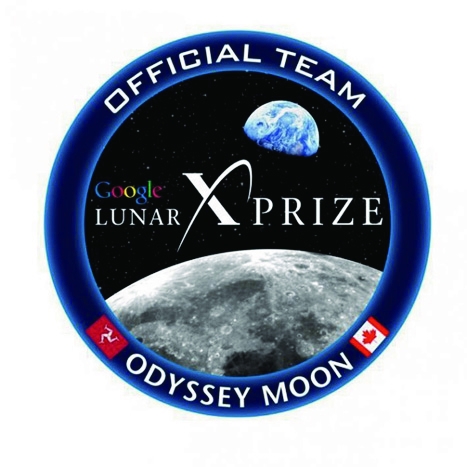
The Google-funded Lunar X Prize is offering an array of awards for various achievementsThe Lunar X Prize calls for teams to safely land a robot on the Moon, have that robot travel 500m over the lunar surface, and send back images and data to Earth. Teams must be at least 90 per cent privately funded. The grand prize is $20m, which will reduce to $15m if a government agency lands first. There is a second prize of $5m, with an additional $4m prize fund for achievements such as operating at night; travelling more than 5km over the lunar surface; detecting water; or landing near an Apollo site, or the landing or crash sites of other probes.
’The X Prize rules allow you to meet the requirement of traversing the surface with a lander that hops,’ he added. ’This solution we’re working on could hop, or it could deposit a rover.’ Beyond this, mindful of the competitive nature of the X Prize, Potter was reluctant to divulge technical details. Odyssey Moon has an agreement with Canadian space engineering specialist MDA Space, which built the ’Canadarm’ robotic arms for the space shuttle and the International Space Station, as its prime contractor for building its lander, and is in talks to use Baikonur Cosmodrome in Khazakhstan, the primary base for Russia’s Soyuz rockets, as its launch site. ’As of the end of the shuttle programme, the Russians have won the space race,’ Potter said. ’We should be respectful of that they’ve got a launch system they’ve been using, reliably, efficiently and successfully, for the past 50 years. Leadership, efficiency and sustainability are absolutely the key features for a launch programme.’
The Lunar X contestants aren’t the only groups with their eyes on the Moon commercialisation prize. Speaking to The Engineer last year, the chairman of Surrey Satellites, Sir Martin Sweeting, outlined his plans to place small communications satellites in orbit around the Moon to provide communications links for technology on the surface, whether it be data relays for unmanned landers or voice, video and internet for astronauts (see The Engineer, 1 November 2010). ’We could be the Vodafone around the Moon, basically,’ he said. ’The areas we’ve focused on in the last few years, robotics and satellites, mean we have the knowledge and expertise to do that.’
“Apollo was expensive, but in terms of its efficiency, robotic exploration bears no comparison”IAN CRAWFORD, BIRKBECK COLLEGE
Indeed, despite the potential of robotic exploration, it’s a return to humans on the Moon that is the ultimate goal. Speaking at the recent UK Space Conference at Warwick University, Prof Ian Crawford of the Department of Earth and Planetary Sciences at Birkbeck College, London, explained that unmanned landers and robot rovers simply can’t carry out the tasks needed to explore the lunar surface efficiently.
’One thing that humans are very efficient at is geology,’ he said. ’During the Apollo 17 mission, the astronauts made three traverses of an 8km wide valley, and a total distance of 32km, effectively in three afternoons. They sampled it very efficiently they brought back 110kg of rocks of different geological types, they deployed a seismic array, they deployed explosive packages to do geophysical analysis of the subsurface and they drilled a 3m borehole.
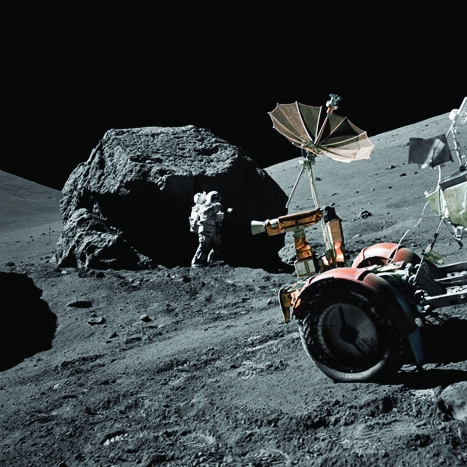
’By contrast, the Opportunity and Spirit rovers have been on Mars for seven years so that’s 14 years of total rover time on the surface and they’ve travelled a total of 29km, haven’t brought any samples back and haven’t done any of the other studies. Apollo was expensive, but in terms of its efficiency, robotic exploration of other planets bears no comparison.’
Crawford argued that manned missions have many inherent advantages over robotic exploration. The need to bring astronauts back means that the missions have built-in sample return capability, he said, and, because manned missions need to carry so much mass, the cost of taking large and complex equipment is a small fraction of the overall programme cost.
Then there are the advantages of having humans around. ’People are very adept at recognising things to be important on the fly, without any pre-expectation of finding anything our billions of years of evolutionary history have given us that capability,’ he said. Moreover, the type of exploration that would be needed to find and exploit He-3 deposits need complex, highly mobile equipment that would be unsuited to robots.
But for the Lunar X Prize entrants, the more modest target of unmanned landers remains the goal. ’A recent cover story on The Economist said that the end of the shuttle represented the end of the space age,’ Michael Potter said. ’The other way of looking at it is that it’s the beginning of the commercialisation of space. The old institutions have become very bureaucratic and confused, and the old government-led monopolistic approach hasn’t been sustainable.’
defying gravity - bringing life to the moon
The lander could be introducing a greenhouse, as well as a red house, to the Moon
The proposed payloads for Odyssey Moon’s lander give an idea of the breadth of sectors with an interest in landing on the Moon. They span a range of human activity, from agriculture to art.
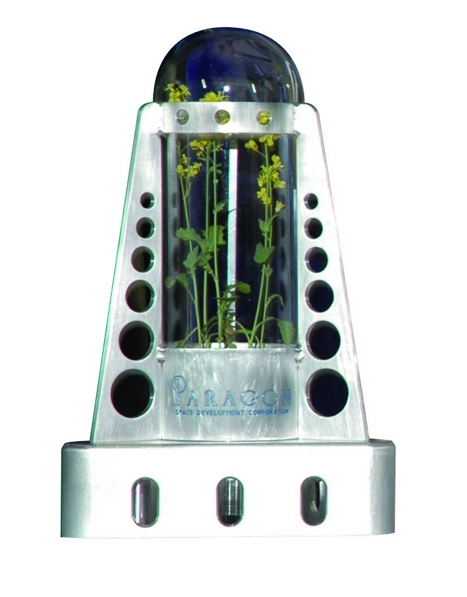
Paragon Space Corporation, based in Michigan, is planning to be the first to grow a plant on the Moon. Working alongside scientists from NASA Ames, it is designing a greenhouse to be carried on Odyssey’s first lander. This, it believes, is a vital step towards an eventual goal of supporting humans on long journeys away from Earth, or in sustaining bases on other planets.
Having developed systems for breeding microorganisms in orbit, Paragon is working with NASA on life-support systems and, according to chief executive Tabor McCallum, is keen to discover how plants might grow away from the Earth. Although plants have been grown in microgravity, he said, nobody has grown a plant in the fractional gravity found on the Moon it isn’t known whether the one-sixth gravity on the lunar surface would be sufficient for plants to grow as they would on Earth.
The greenhouse, which will be called Lunar Oasis, will be a small unit, probably cylindrical. The walls will have to block out harmful solar radiation while letting in the wavelengths of sunlight vital to the plant. It will also have to incorporate oxygen/carbon dioxide exchange equipment.
Another proposed payload is somewhat quirkier. Swedish artist Mikael Genberg is planning to put a traditional Swedish holiday home a red-walled cottage on the Moon. It will be inflatable, made from a material that hardens under ultraviolet light and housed within a spherical robot rover developed by the Ängström Space Technology Centre, part of Uppsala University. The cottage, which will be full size, will inflate around the rover, which will also carry scientific instruments.
Genberg has already placed red-walled cottages in some unlikely places in Sweden, including in trees and underwater, but clearly, the sky is the limit.




Report highlights significant impact of manufacturing on UK economy
I am not convinced that the High Value Manufacturing Centres do anything to improve the manufacturing processes - more to help produce products (using...